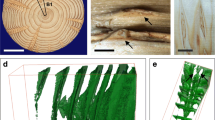Abstract.
Tissue-specific accumulation of phenylpropanoids was studied in mycorrhizas of the conifers, silver fir (Abies alba Mill.), Norway spruce [Picea abies (L.) Karst.], white pine (Pinus strobus L.), Scots pine (Pinus silvestris L.), and Douglas fir [Pseudotsuga menziesii (Mirbel) Franco], using high-performance liquid chromatography and histochemical methods. The compounds identified were soluble flavanols (catechin and epicatechin), proanthocyanidins (mainly dimeric catechins and/or epicatechins), stilbene glucosides (astringin and isorhapontin), one dihydroflavonol glucoside (taxifolin 3′-O-glucopyranoside), and a hydroxycinnamate derivative (unknown ferulate conjugate). In addition, a cell wall-bound hydroxycinnamate (ferulate) and a hydroxybenzaldehyde (vanillin) were analysed. Colonisation of the root by the fungal symbiont correlated with the distribution pattern of the above phenylpropanoids in mycorrhizas suggesting that these compounds play an essential role in restricting fungal growth. The levels of flavanols and cell wall-bound ferulate within the cortex were high in the apical part and decreased to the proximal side of the mycorrhizas. In both Douglas fir and silver fir, which allowed separation of inner and outer parts of the cortical tissues, a characteristic transversal distribution of these compounds was found: high levels in the inner non-colonised part of the cortex and low levels in the outer part where the Hartig net is formed. Restriction of fungal growth to the outer cortex may also be achieved by characteristic cell wall thickening of the inner cortex which exhibited flavanolic wall infusions in Douglas fir mycorrhizas. Long and short roots of conifers from natural stands showed similar distribution patterns of phenylpropanoids and cell wall thickening compared to the respective mycorrhizas. These results are discussed with respect to co-evolutionary adaptation of both symbiotic partners regarding root structure (anatomy) and root chemistry.
Similar content being viewed by others
Author information
Authors and Affiliations
Additional information
Received: 25 May 1998 / Accepted: 6 November 1998
Rights and permissions
About this article
Cite this article
Weiss, M., Schmidt, J., Neumann, D. et al. Phenylpropanoids in mycorrhizas of the Pinaceae. Planta 208, 491–502 (1999). https://doi.org/10.1007/s004250050586
Issue Date:
DOI: https://doi.org/10.1007/s004250050586




